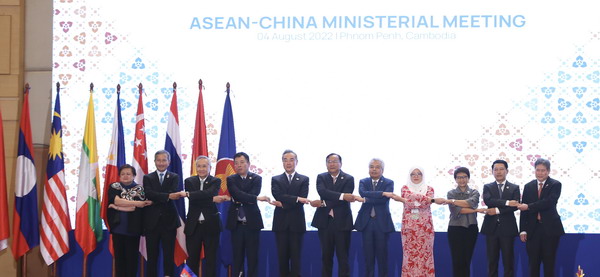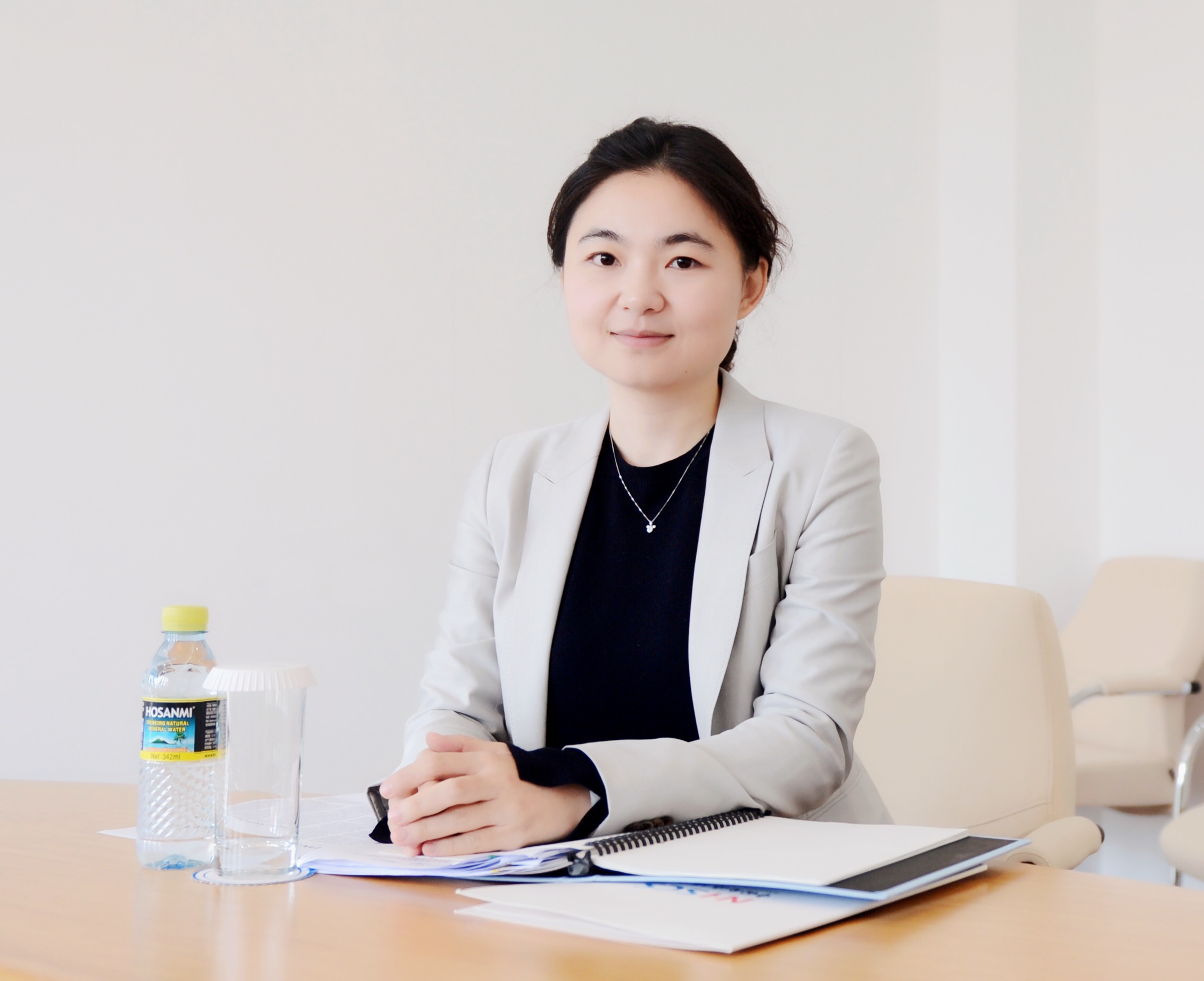On November 4, 2002, during the China-ASEAN Leaders' Meeting held in Phnom Penh, the foreign ministers and representatives of foreign ministers from China and ASEAN members signed the Declaration on the Conduct of Parties in the South China Sea (DOC). Since 2018, the negotiation on the Code of Conduct in the South China Sea (COC) has accelerated and entered second reading. Despite the impact of COVID-19, all the parties still express the need of speeding up the negotiation of the COC.

China-ASEAN Ministerial Meeting, 4th August, 2022
Hu Bo: Objective Assessment of the Current Situation and Pragmatic Grasping the starting point of the COC consultation

The situation in the South China Sea over the past 20 years
A lot has happened in the South China Sea over the years. Disputes in the South China Sea are intensified with the unending competitions over the diplomacy, law, and the on-the-ground presence or control. As the strategic competition of major powers intensifies, the attention and intervention of extra-regional countries increase significantly. Despite this, the situation in the South China Sea has remained generally stability that maintained a situation of “fighting but not breaking”. It is inseparable from the concerted efforts of China and ASEAN members, especially the claimants, which is also undoubtedly the greatest achievement of the DOC framework.
The South China Sea remains a hot topic of maritime disputes and geopolitics in the world, but it has not deteriorated into what some media, think-tanks and countries sensationalized. The exaggeration of the tension in the South China Sea is largely because that someone spares no effort in selling “South China Sea anxiety”. Some media and think-tanks who seeking development in chaos, are keen to make big news about the South China Sea. Some extra-regional countries with ulterior motives hope to realize their region strategies by exaggerating the tension in the South China Sea. Therefore, the real situation of the South China Sea is obviously different from the narrative of some media and some Western countries.
The way of the future
Currently, the United States ostensibly emphasizes maintaining a “rules-based international order”, but actually trying to create a maritime order to exclude China in the South China Sea and even the Indo-Pacific region. China expresses its desire to establish a regional order based on international law, which respects the legal rights of extra-regional countries but opposes them intervening in the South China Sea disputes and implementing the “gunboat policy” in there. Most ASEAN countries cherish ASEAN Centrality and are unwilling to choose sides between China and the United States.
In fact, neither China, the United States nor ASEAN countries can establish an exclusive, closed order in the region. The South China Sea is a major international crossing point, which indeed concerns the interests of many countries or regions in the world. But the degree of interest relationship is different. The greatest ties are the coastal countries of the South China Sea, followed by neighboring countries and extra-regional countries. Therefore, the “Dual-track” approach is a reasonable mode of building order, that is, the disputes are settled by China and relevant countries in the South China Sea through negotiation, while the peace and stability in the South China Sea is jointly maintained by China and ASEAN countries. Both DOC and COC are the products of the “Dual-track” approach, that is, on the premise of shelving maritime disputes, China and ASEAN countries jointly discuss the maritime rule issues in the South China Sea. This approach complies with common practice, and it is similar with the governance modes in other hotspot sea areas, such as the Arctic, in which core issues related to sovereignty and maritime delimitation can only be decided by the “Arctic eight”, while observer states are welcome to participate in global maritime governance issues.
Some extra-regional powers frequently emphasize that the South China Sea is related to their major interests, but in any case, such relationship or connection cannot be compared with countries in the regi
COC negotiation
So far, China has shown a very open attitude in the COC negotiation, releasing great enough goodwill and sincerity. However, COC consultation process and results are decided by 11 parties. Recently, the South China Sea Arbitration Ruling and the increased involvement of extra-regional countries give some unrealistic expectations to some ASEAN countries. They are trying to abandon the “Dual-track” approach and have raised the asking price significantly, which made the negotiation become difficult.
Neither the DOC nor the COC is a platform for resolving disputes in the South China Sea. Any attempt to raise a negotiating price is intended to prevent or destroy consultations. Some countries need to be clearly aware that China is an immovable neighbor, and is the biggest stakeholder in the situation of the South China Sea. Patience, pragmatism and reciprocity pave the way to success.
China is a great power and should assume greater responsibility in maintaining peace and stability in the region. While, China is also a sovereign state and needs to be treated as an equal. All the negotiation means compromise, which is two-way rather than one-sided process. Demanding too much on China is not the way to be good-neighbor and friend, nor does it serve the interests of all parties as well as the whole region.
Lei Xiaolu:Adhering to the spirit of the DOC is the key to COC negotiation

This year marks the 20th anniversary of the signing of the Declaration on the Conduct of Parties in the South China Sea (DOC), and on July 25, officials, think tanks, experts and scholars from ASEAN countries and China commemorated this landmark document. Those who witnessed the negotiation and signing of the DOC reviewed the conclusion of the DOC, summarized the precious historical experience of its negotiation, and fully affirmed the important role of the DOC in maintaining peace and stability in the South China Sea. Twenty years ago, , China and ASEAN countries seized the historic opportunity to achieve 20 years of leapfrog development in the region by easing political and security ties, to which the DOC is credited. Moreover, the valuable experience accumulated in the negotiation of the DOC has provided a reference for the consultations on a code of conduct (COC).

Foreign Minister of China Wang Yi gave speech at the 20th anniversary of the signing of the Declaration on the Conduct of Parties in the South China Sea (DOC)
The spirit and inspiration of the DOC
The signing of the DOC is the result of mutual respect and consensus between China and ASEAN countries. Mutual respect is not only reflected in the negotiations, but also in the specific provisions of the DOC, and in the subsequent practice of China and ASEAN countries in the past twenty years. Maintaining peace and stability in the South China Sea and promoting pragmatic cooperation is a common responsibility and needs the joint efforts between China and ASEAN members, rather than one providing military and security protection to the others or integrating the other countries into a security/defense system that is in the interests of the major powers themselves. The "dual-track approach" also confirms that peace and stability in the South China Sea are to be jointly maintained by China and ASEAN countries. In this sense, the DOC has already provided a framework of principles for the COC consultations.
To reach consensus and to accommodate all parties’ concern embodied in the conclusion of the DOC reflects the wisdom and tradition of Southeast Asian countries and China. The compromise of all parties, which breaks through the self-restraint in the consensus, and the search for the greatest common denominator of the interests of all parties are the important guarantee for the successful conclusion and full implementation of the DOC.
Challenges to the consultation on the COC
China and ASEAN countries live in a time that has changed dramatically from 20 years ago. Compared to the past, ASEAN countries and China have deeper concerns about regional security and sovereignty and maritime rights. The South China Sea Arbitration has not only failed to resolve disputes over maritime rights, but has also become a huge obstacle to the management of conflicts and resolution of disputes over territorial sovereignty and maritime rights, as well as to the promotion of practical maritime cooperation. The extra-regional powers have increased their intervention in the region on issues such as rule-making and strengthened their military presence in the region.
The need for the COC to be more substantive on the basis of the DOC has itself raised higher threshold for the COC consultation. China and ASEAN countries still have different positions on the geographical scope of the COC, its legally binding effect, the relationship with the DOC and other relevant rules of international law, and dispute settlement mechanisms. These specific issues were not finally resolved during the negotiation of the DOC, requiring greater patience and compromise from all countries.
The prospects of future COC
We have different expectations for the COC, but the conditions are ripe for conclusion of the COC. Twenty years ago, when many disputes were not finally resolved, China and ASEAN countries, with the aim and purpose of maintaining peace and stability in the region, concluded the DOC with the greatest consensus reached at that time. We cannot expect to resolve in three to five years all the issues that were not resolved in the ten years of the DOC negotiations, or even to resolve all the conflicts of regional maritime rules in search of a package deal.
A perfect COC cannot be achieved overnight, but needs to be realized step by step, and requires China and ASEAN countries to continuously build mutual trust and find new paths to solve problems in the process of consultations, concluding international documents on regional rules, and promoting practical cooperation. It can be boldly imagined that a document called "The South China Sea code of conduct" is not the end of the regional rules-making, and the regional rules in the South China Sea may be composed of the DOC, the COC, and agreements on specific matters together with other agreements/treaties and international documents. Even if the COC do not accommodate all parties’ interests and concerns, they must be the largest consensus that can be achieved in reality. The openness of the DOC and the COC will provide a constant impetus for the continuous improvement of regional rules.
In the new era, as long as China and ASEAN countries uphold the spirit of the DOC and focus on the overall situation of regional peace, stability and prosperity, they will surely make significant progress in the consultations on the COC.
Yan Yan: Code of Conduct: Navigating a Bumpy Road in the Post-pandemic Era

In retrospect, the year 2019 witness the birth of the single draft negotiation text (SDNT) and the ending of the first reading. The fast track of the negotiation has gained high attention and appreciation from the international community. China and ASEAN countries all look forward to the bright future of completing the consultation within 3 years.
However, a sudden epidemic of the Covid-19 forced the fast-track COC negotiation to slow down, but the countries continued to move forward with the second reading in a flexible manner, such as video conferencing. The deceleration of the negotiation has brought a window of opportunity for rule-making in the South China Sea region. Unilateral maritime activities by regional countries have been on the rise, and military activities by extra-territorial countries are intensifying. Although the situation in the South China Sea is generally under control, it is full of crises, with positive changes and negative factors deeply intertwined.
This year marks the 20th anniversary of the signing of the Declaration on the Conduct of Parties in the South China Sea. Most notably, on May 25, China and ASEAN countries held the 36th joint working group meeting on the implementation of the DOC and COC negotiation in Siem Reap, Cambodia. This was the first offline meeting of the working group since the pandemic, which marks the return of the consultations to the normal track of face-to-face.
In recent years, some extra-regional countries’ interference with the negotiation process, and the negative impact of the South China Sea Arbitration ruling have led to more unilateral actions by claimant States in the region, casting a shadow over the atmosphere of the negotiation. Since the arbitration ruling came out on July 12, 2016, some claimant states have reassessed their goals and cards to play on the negotiation table, and some have even proposed unrealistic proposals. In addition, some extra-regional countries, which have always tried to muddling the waters in the South China Sea, continue to question China's sincerity and try to interfere and intervene in the consultation process.
In fact, unilateral oil and gas exploitation activities of some South China Sea coastal states, as well as the fisheries conflicts in the disputed waters, have increasingly highlighted the importance of the COC as a crisis management and prevention mechanism to restrain the maritime behavior of all neighboring countries. At the same time, the lack of regional cooperation regime is one of the important reasons why it is difficult to deepen maritime cooperation in the South China Sea. The construction of a more practical and effective maritime cooperation mechanism is not only to provide institutional guarantee to the maritime cooperation in the South China Sea, but also to set an example for future global ocean governance.
The DOC, signed by China and ten ASEAN countries in 2002, has played a crucial role in safeguarding the peace and stability in the South China Sea over a long period of time. With the opening of a new round of face-to-face negotiation and the gradual progress of the second reading, it is foreseeable that the debate over the rules and order of the South China Sea in the post-epidemic era around the COC will become one of the most complicated factors affecting the region.
In the difficult and tortuous process of future consultations, differences will always exist, and compromises by the negotiating parties will be inevitable. What should always be borne in mind is that Article 10 of the Declaration has already set 20 years ago the conclusion of COC as a long-term goal. This is also the common wish and commitment of China and the ten ASEAN countries.
The future process of the COC negotiation depends on the political will and cooperation consensus of the negotiating countries.
The road ahead will be long; our climb will be steep.



